Assessing the Ecosystem Services Potential of Endemic Floras: A Systematic Review on the Greek Endemics of Peloponnese
Abstract
:1. Introduction
- (a)
- present a review of the studies focusing on ES provided by endemic taxa of Peloponnese and on the chemical composition of their essential oils,
- (b)
- describe the distribution pattern of this endemic flora in Peloponnese,
- (c)
- extract a list of relative non-endemic taxa based on taxonomic and phylogenetic studies and summarize their properties and chemical compositions,
- (d)
- conclude on the actual and potential ES of the endemic plants present in Peloponnese,
- (e)
- pinpoint data gaps and suggest leads for further studies,
- (f)
- provide scientific evidence for sustainable management and integration of the results in sustainable agricultural and conservation practice.
2. Materials and Methods
2.1. Endemic Taxa
2.2. Non-Endemic Taxa and Taxonomic Relatives
2.3. Non-Endemic Taxa and Phylogenetic Relatives
2.4. Review Process
- −
- [“Medical” + “name of the taxon”],
- −
- [“Medicinal” + “name of the taxon”],
- −
- [“Aromatic” + “name of the taxon”],
- −
- [“Properties” + “name of the taxon”],
- −
- [“Uses” + “name of the taxon”],
- −
- [“Activity” + “name of the taxon”],
- −
- [“name of the taxon”].
2.5. Definitions for the Ecosystem Services
- An ingredient for the preparation of local to common dishes (eaten raw or cooked, spice, food preservative);
- An ingredient for the preparation of local to common beverages (tea, milk preparations);
- Material for the preparation of perfumes or cosmetics;
- A plant with an acknowledged powerful scent that could be used for floristic, food or cosmetic applications.
- Possessing medicinal or medical properties with scientific proofs (i.e., antioxidant, anti-acetylcholinesterase, skin protection, anti-inflammatory, antinociceptive, etc.);
- Already exploited as plant material for pharmaceutical productions (i.e., drugs, homeopathy);
- Used for veterinary purposes that could potentially be widened into human care (i.e., anti-parasite, wound healing, etc.).
- Used in traditional medicine on a local to wide scale (i.e., against sore throat, epilepsy, stomach aches, as hepatoprotective, antispasmodic, to cure wounds, to regulate diabetes, anti-malarial etc.);
- Used for para-medical applications (i.e., aphrodisiac, hypnotic, psychedelic, etc.).
- Efficient treatments against viruses, fungi, bacteria, yeasts, parasites, worms. This excludes insecticidal, molluscicidal and nematocidal applications as well as uses for plant diseases that are integrated to the following category.
- Having applications in the knowledge or mastering of landscapes (i.e., ornamental, habitat indicator, habitat restoration, resistance to extreme soil conditions, etc.);
- Beneficial for non-human species (i.e., veterinary uses, host-plant for insects, bee attractant, etc.);
- Beneficial for agricultural productions or necessary to reduce diseases’ propagations by vectors (i.e., herbicidal, plant protection, cover crop, fodder, fertilizer, rodenticide, insecticide, etc.);
- A direct use of nature by humans for traditional or cultural purposes (i.e., religious, cultural);
- A tool for nature protection awareness (i.e., use in botanical gardens, touristic trails, presence on historical sites).
- Exploited for industrial applications (i.e., reducing agent, solvent, glue, etc.);
- Used for traditional applications linked to craftsmanship (i.e., tincture, wood uses for furniture, instrument, fuel, etc.);
- Exploited in non-traditional food processes (i.e., ice-cream production).
2.6. Data Analysis
3. Results
3.1. Review Characteristics
3.1.1. Endemic Taxa Review
3.1.2. Non-Endemic Taxa Review
3.2. Endemic Flora Statistics
3.3. Habitats and Distribution of Endemic Flora
3.4. Endemic Flora Properties and Chemical Compositions
3.4.1. General Results on Ecosystem Services
3.4.2. Aromatic
3.4.3. Medical
3.4.4. Traditional Medicine
3.4.5. Antimicrobial
3.4.6. Environmental Benefit
3.4.7. Spatial Distribution of Ecosystem Services
3.4.8. Essential Oils Main Components
3.5. Non-Endemic Flora Additional Dataset
3.5.1. Taxonomy Relatives’ Properties
3.5.2. Phylogeny Relatives’ Properties
3.5.3. Taxonomy and Phylogeny Relatives’ Main Components
3.6. Cross Analysis between Endemic and Non-Endemic Datasets
4. Discussion
4.1. A wide Diversity Accurate to Greek Flora
4.2. Gaps in the Knowledge of This Diversity
- Complicated access to the natural habitat of the species and localization of the growth spot,
- Limited plant material for small populations, which limits both the quantity of analysis and the potential ulterior applications,
- Limited productivity in essential oils for several families,
- Lack of relevance in the scientific context of one laboratory,
- Lack of time, workforce and funds,
- Lack of appeal for families with no well-acknowledged properties, etc.
4.3. Evaluating the Potential of Endemic Plants through Related Taxa
4.4. Stakes and Clues for the Protection of Important Flora
4.5. Implications for Sustainable Rural Management
5. Conclusions
Supplementary Materials
Author Contributions
Funding
Acknowledgments
Conflicts of Interest
References
- Schipfer, F.; Kranzl, L.; Leclère, D.; Sylvain, L.; Forsell, N.; Valin, H. Advanced biomaterials scenarios for the EU28 up to 2050 and their respective biomass demand. Biomass Bioenergy 2017, 96, 19–27. [Google Scholar] [CrossRef]
- Perera, F. Pollution from Fossil-Fuel Combustion is the Leading Environmental Threat to Global Pediatric Health and Equity: Solutions Exist. Int. J. Environ. Res. Public Health 2018, 15, 16. [Google Scholar] [CrossRef] [PubMed] [Green Version]
- Kawashima, N.; Yagi, T.; Kojima, K. How Do Bioplastics and Fossil-Based Plastics Play in a Circular Economy? Macromol. Mater. Eng. 2019, 304, 1900383. [Google Scholar] [CrossRef]
- Yuan, H.; Ma, Q.; Ye, L.; Piao, G. The Traditional Medicine and Modern Medicine from Natural Products. Molecules 2016, 21, 559. [Google Scholar] [CrossRef] [Green Version]
- Valli, M.; Bolzani, V.S. Natural Products: Perspectives and Challenges for use of Brazilian Plant Species in the Bioeconomy. An. Acad. Bras. Cienc. 2019, 91, e20190208. [Google Scholar] [CrossRef] [Green Version]
- Ngo, L.T.; Okogun, J.I.; Folk, W.R. 21st Century natural product research and drug development and traditional medicines. Nat. Prod. Rep. 2013, 30, 584–592. [Google Scholar] [CrossRef]
- Eldeen, I.M.S.; Effendy, M.A.W.; Tengku-Muhammad, T.S. Ethnobotany: Challenges and Future Perspectives. Res. J. Med. Plants 2016, 10, 382–387. [Google Scholar] [CrossRef] [Green Version]
- Tewari, D.; Stankiewicz, A.M.; Mocan, A.; Sah, A.N.; Tzvetkov, N.T.; Huminiecki, L.; Horbańczuk, J.O.; Atanasov, A.G. Ethnopharmacological Approaches for Dementia Therapy and Significance of Natural Products and Herbal Drugs. Front. Aging Neurosci. 2018, 10, 3. [Google Scholar] [CrossRef] [Green Version]
- World Health Organization. WHO Global Report on Traditional and Complementary Medicine; World Health Organization: Geneva, Switzerland, 2020. [Google Scholar]
- El-Darier, S.M.; Rashed, S.A.; Fayez, A.; Hassanein, S.S.; Sharaby, M.R.; Tawfik, N.M.; Mansour, H.; Adel, M. Medicinal plant-derived compounds as potential phytotherapy for COVID-19: Future perspectives. J. Pharmacogn. Phytother. 2021, 13, 68–81. [Google Scholar]
- Scarborough, J. Theophrastus on Herbals and Herbal Remedies. J. Hist. Biol. 1978, 11, 353–385. [Google Scholar] [CrossRef]
- Osbaldeston, T.A. The Herbal of Dioscorides the Greek; Ibidis Press: Johannesburg, South Africa, 2000. [Google Scholar]
- Georghiou, K.; Delipetrou, P. Patterns and traits of the endemic plants of Greece. Bot. J. Linn. Soc. 2010, 162, 130–153. [Google Scholar] [CrossRef] [Green Version]
- Dimopoulos, P. Vascular Plants of Greece: An Annotated Checklist; Botanischer Garten und Botanisches Museum Berlin-Dahlem: Berlin, Germany, 2013. [Google Scholar]
- Dimopoulos, P.; Raus, T.; Bergmeier, E.; Constantinidis, T.; Iatrou, G.; Kokkini, S.; Strid, A.; Tzanoudakis, D. Vascular plants of Greece: An annotated checklist. Supplement. Willdenowia 2016, 46, 301–347. [Google Scholar] [CrossRef] [Green Version]
- Allen, D.; Bilz, M.; Leaman, D.J.; Miller, R.M.; Timoshyna, A.; Window, J. European Red List of Medicinal Plants; Publications Office of the European Union: Luxembourg, 2014. [Google Scholar]
- Kokkoris, I.P.; Mallinis, G.; Bekri, E.S.; Vlami, V.; Zogaris, S.; Chrysafis, I.; Mitsopoulos, I.; Dimopoulos, P. National Set of MAES Indicators in Greece: Ecosystem Services and Management Implications. Forests 2020, 11, 595. [Google Scholar] [CrossRef]
- Fisher, B.; Turner, R.K.; Morling, P. Defining and classifying ecosystem services for decision making. Ecol. Econ. 2009, 68, 643–653. [Google Scholar] [CrossRef] [Green Version]
- Martinez-Harms, M.J.; Bryan, B.A.; Balvanera, P.; Law, E.A.; Rhodes, J.R.; Possingham, H.P.; Wilson, K.A. Making decisions for managing ecosystem services. Biol. Conserv. 2015, 184, 229–238. [Google Scholar] [CrossRef] [Green Version]
- Posner, S.M.; McKenzie, E.; Ricketts, T.H. Policy impacts of ecosystem services knowledge. Proc. Natl. Acad. Sci. USA 2016, 113, 1760–1765. [Google Scholar] [CrossRef] [Green Version]
- Leaman, D.J. The international standard for sustainable wild collection of medicinal and aromatic plants (ISSC-MAP), WG2-CS4 Annex. In Proceedings of the International Expert Workshop on CITES Non-Detriment Findings, Perennial Plant Working Group (Ornamentals, Medicinal and Aromatic Plants), Cancun, Mexico, 17–22 November 2008. [Google Scholar]
- Stavropoulos, N. Greece: Country Report to the FAO International Technical Conference on Plant Genetic Resources; FAO: Leipzig, Germany, 1996. [Google Scholar]
- Strid, A. The botanical exploration of Greece. Plant Syst. Evol. 2020, 306, 27. [Google Scholar] [CrossRef]
- Cheminal, A.; Kokkoris, I.P.; Strid, A.; Dimopoulos, P. Medicinal and Aromatic Lamiaceae Plants in Greece: Linking Diversity and Distribution Patterns with Ecosystem Services. Forests 2020, 11, 661. [Google Scholar] [CrossRef]
- European Commission. Mapping and Assessment of Ecosystems and Their Services: Trends in Ecosystems and Ecosystem Services in the European Union between 2000 and 2010; European Commission, Joint Research Centre, Institute for Environment and Sustainability: Luxembourg, 2015. [Google Scholar]
- Mapping and Assessment for Integrated Ecosystem Accounting, MAIA Portal. Available online: https://maiaportal.eu/ (accessed on 17 March 2022).
- Vascular Plants Checklist of Greece: Flora of Greece, An Annotated Checklist. Flora of Greece Web. Available online: https://portal.cybertaxonomy.org/flora-greece/intro (accessed on 10 March 2022).
- The IUCN Red List of Threatened Species. Available online: https://www.iucnredlist.org/en (accessed on 17 March 2022).
- Center for History and New Media, Zotero. University George Mason: Center for History and New Media, 2021. [Microsoft Windows]. Available online: www.zotero.org (accessed on 7 March 2022).
- Delitheos, A.; Tiligada, E.; Yannitsaros, A.; Bazos, I. Antiphage activity in extracts of plants growing in Greece. Phytomedicine 1997, 4, 117–124. [Google Scholar] [CrossRef]
- Sharifi-Rad, M.; Varoni, E.M.; Iriti, M.; Martorell, M.; Setzer, W.N.; Contreras, M.D.; Salehi, B.; Soltani-Nejad, A.; Rajabi, S.; Tajbakhsh, M.; et al. Carvacrol and human health: A comprehensive review. Phytother. Res. 2018, 32, 1675–1687. [Google Scholar] [CrossRef]
- Marchese, A.; Orhan, I.E.; Daglia, M.; Barbieri, R.; di Lorenzo, A.; Nabavi, S.F.; Gortzi, O.; Izadi, M.; Nabavi, S.M. Antibacterial and antifungal activities of thymol: A brief review of the literature. Food Chem. 2016, 210, 402–414. [Google Scholar] [CrossRef] [PubMed]
- Taha, Z.A.; Ajlouni, A.M.; Al-Hassan, K.A.; Hijazi, A.K.; Faiq, A.B. Syntheses, characterization, biological activity and fluorescence properties of bis-(salicylaldehyde)-1,3-propylenediimine Schiff base ligand and its lanthanide complexes. Spectrochim. Acta A Mol. Biomol. Spectrosc. 2011, 81, 317–323. [Google Scholar] [CrossRef] [PubMed]
- Ainscough, E.W.; Brodie, A.M.; Dobbs, A.J.; Ranford, J.D.; Waters, J.M. Antitumour copper (II) salicylaldehyde benzoylhydrazone (H2sb) complexes: Physicochemical properties and the single-crystal X-ray structures of [{Cu(H2sb)(CCl3CO2)2}2] and [{Cu(Hsb) (ClO4) (C2H5OH)}2] and the related salicylaldehyde acetylhydrazone (H2sa) complex, [Cu(Hsa)Cl(H2O)]·h2O. Inorg. Chim. Acta 1998, 267, 27–38. [Google Scholar]
- Kougioumoutzis, K.; Kokkoris, I.P.; Panitsa, M.; Strid, A.; Dimopoulos, P. Extinction Risk Assessment of the Greek Endemic Flora. Biology 2021, 10, 195. [Google Scholar] [CrossRef]
- Ministry of Environment and Energy. Δημόσια διαβούλευση για τις τρείς πρώτες Ειδικές Περιβαλλοντικές Μελέτες για τις περιοχές «Νatura 2000», σε Κρήτη, Έβρο και Πελοπόννησο—Public Consultation for the First Three Special Environmental Studies for the Areas “Natura 2000”, in Crete, Evros and Peloponnese. Ministry of Environment and Energy: Greece, 10-01-2022. Available online: https://ypen.gov.gr/dimosia-diavoulefsi-gia-tis-treis-protes-eidikes-perivallontikes-meletes-gia-tis-perioches-natura-2000-se-kriti-evro-kai-peloponniso/ (accessed on 17 March 2022).
- Tsakiri, M.; Koumoutsou, E.; Kokkoris, I.P.; Trigas, P.; Iliadou, E.; Tzanoudakis, D.; Dimopoulos, P.; Iatrou, G. National Park and UNESCO Global Geopark of Chelmos-Vouraikos (Greece): Floristic Diversity, Ecosystem Services and Management Implications. Land 2022, 11, 33. [Google Scholar] [CrossRef]
- Solomou, A.D.; Martinos, K.; Skoufogianni, E.; Danalatos, N.G. Medicinal and Aromatic Plants Diversity in Greece and Their Future Prospects: A Review. Agric. Sci. 2016, 4, 9–20. [Google Scholar] [CrossRef] [Green Version]
- European Commission. The European Green Deal. Communication from the Commission to the European Parliament, the European Council, the Council, the European Economic and Social Committee and the Committee of the Regions, Report COM (2019) 640 Final; European Commission: Brussels, Belgium, 2019. [Google Scholar]
- Kougioumoutzis, K.; Kokkoris, I.P.; Panitsa, M.; Trigas, P.; Strid, A.; Dimopoulos, P. Plant Diversity Patterns and Conservation Implications under Climate-Change Scenarios in the Mediterranean: The Case of Crete (Aegean, Greece). Diversity 2020, 12, 270. [Google Scholar] [CrossRef]
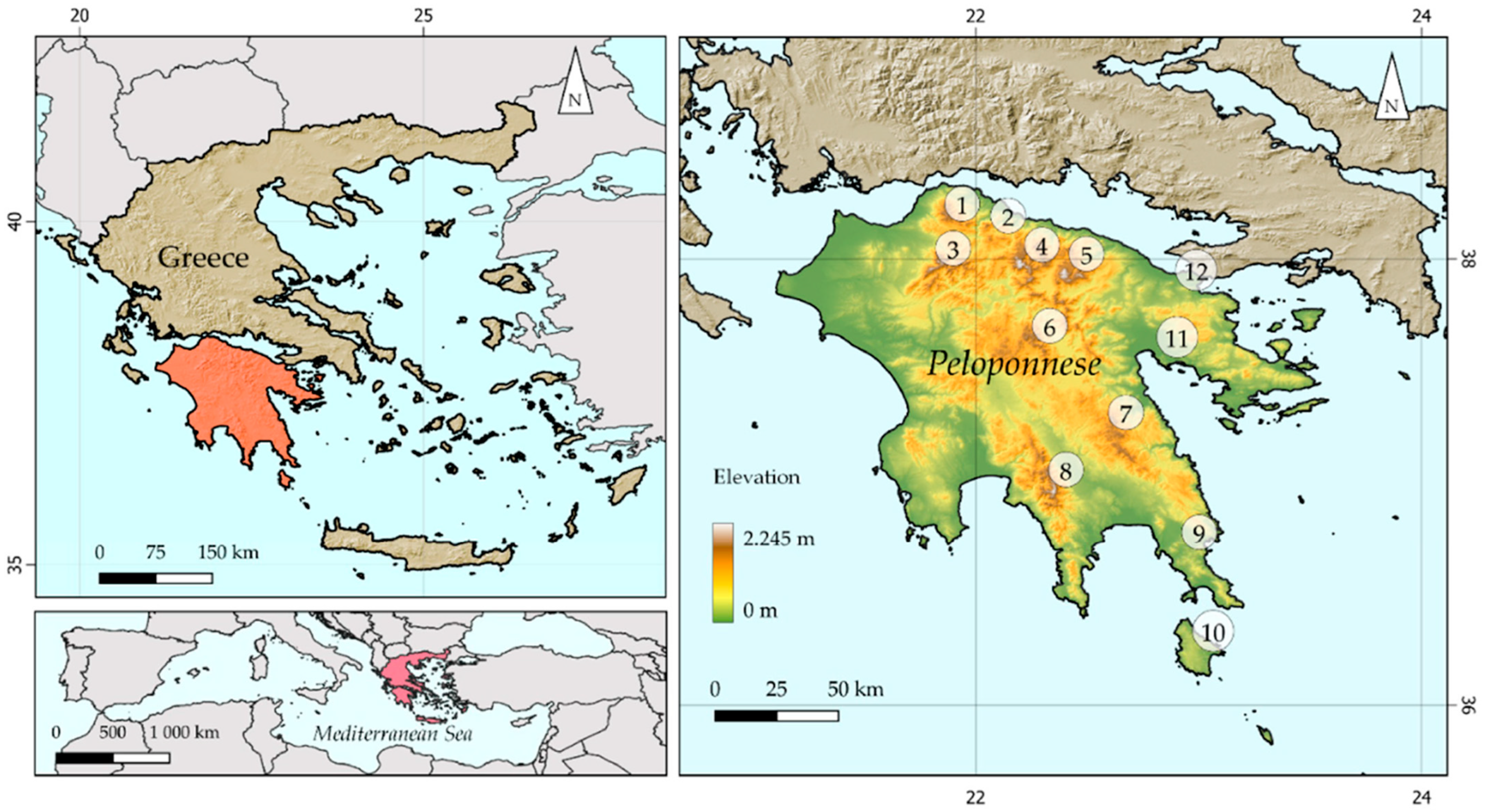
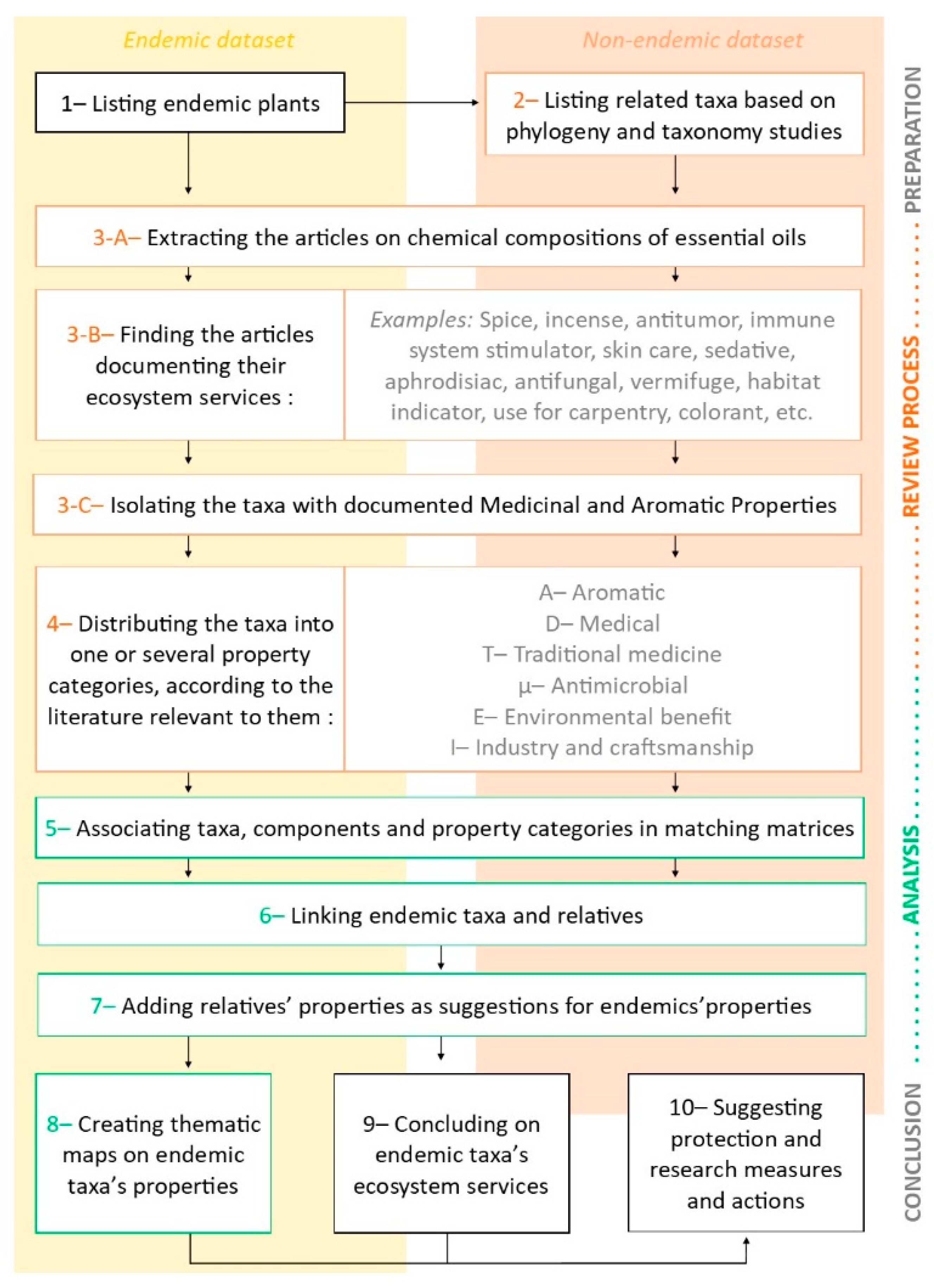
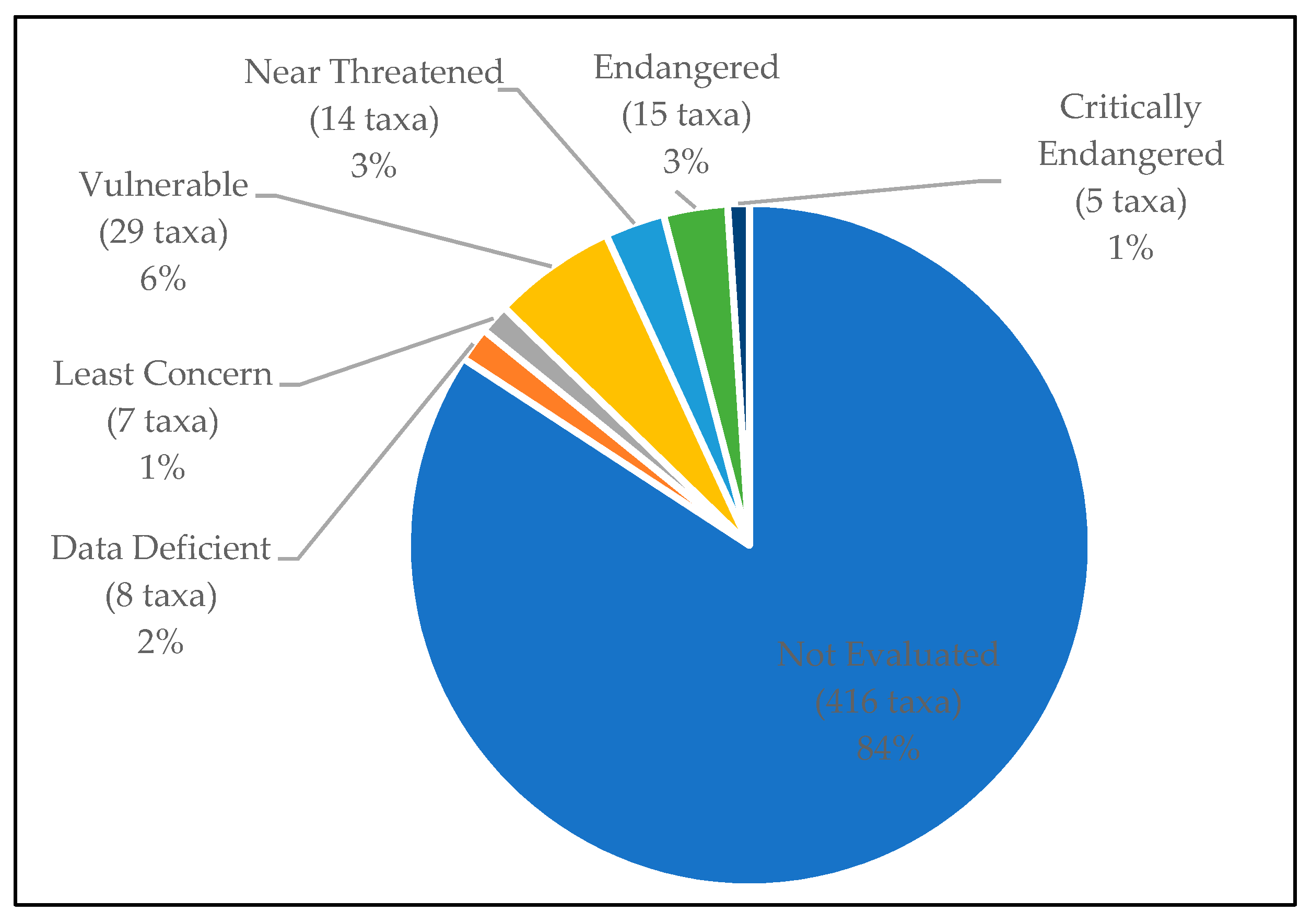
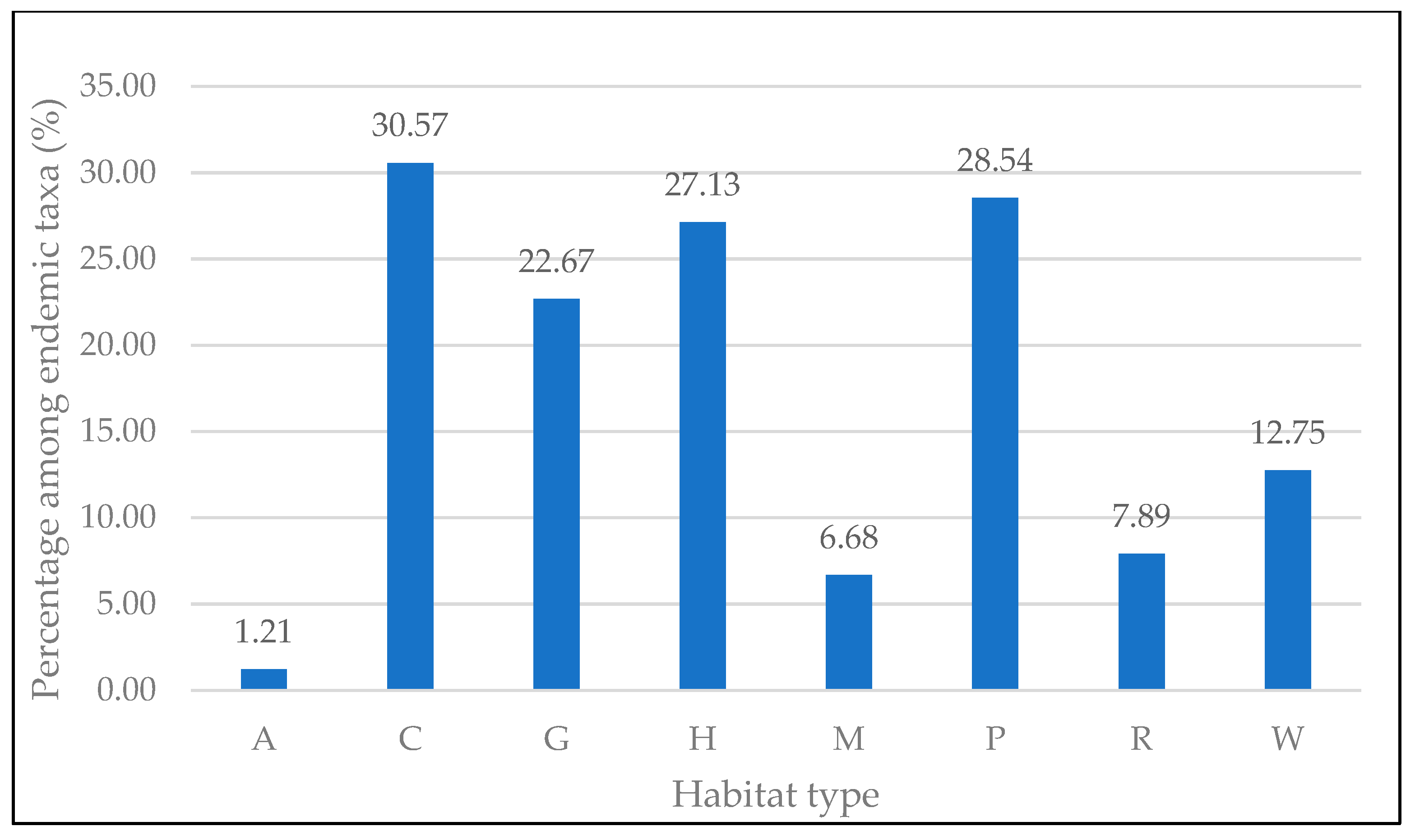

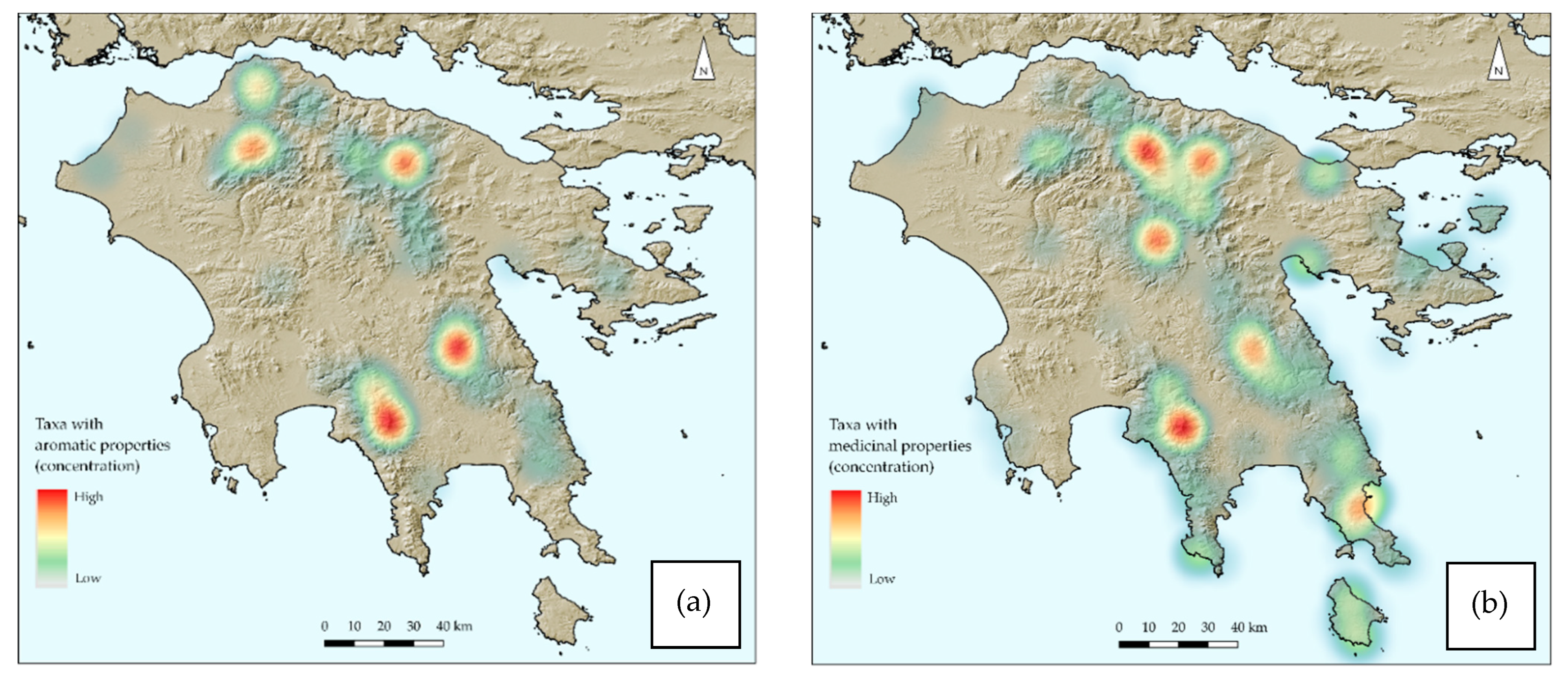

| Species | N° of Articles | Species | N° of Articles |
|---|---|---|---|
| Achillea millefolium (Asteraceae) | 48,700 | Lamium album (Lamiaceae) | 9120 |
| Lonicera caerulea (Caprifoliaceae) | 5550 | Lamium amplexicaule (Lamiaceae) | 10,200 |
| Silene vulgaris (Caryophyllaceae) | 15,900 | Satureja cuneifolia (Lamiaceae) | 1420 |
| Crocus sativus (Iridaceae) | 29,600 | Ruta chalepensis (Rutaceae) | 4850 |
| Ballota nigra (Lamiaceae) | 6480 | Sideritis scardica (Lamiaceae) | 1080 |
| Total Number of Peloponnese Endemics | N° of Pe. Endemics with Documented Properties | N° of Pe. Endemics without Documented Properties | |||
|---|---|---|---|---|---|
| Number of Taxa | % of Total | Number of Taxa | % of Total | ||
| N° of endemic taxa (subspecies or species) | 494 | 122 | 24.7 | 372 | 75.3 |
| N° of genera with endemic taxa | 171 | 81 | 47.4 | 90 | 52.6 |
| N° of families with endemic taxa | 49 | 33 | 67.3 | 16 | 32.7 |
| Aromatic | Medical | Traditional Medicine | Antimicrobial | Environment Benefit | |
|---|---|---|---|---|---|
| Taxa with proved properties | 13 | 28 | 8 | 31 | 71 |
| Taxa with suspected properties | 4 | 3 | 2 | 0 | 11 |
| Taxa with a property proved to be absent | 0 | 4 | 0 | 6 | 1 |
| Total number of taxa with documentation for this category of properties | 17 | 35 | 10 | 37 | 83 |
| Total number of taxa with documentation for this category of properties in % | 3.44 | 7.09 | 2.02 | 7.49 | 16.80 |
| N° of genera concerned | 14 | 27 | 9 | 30 | 56 |
| N° of families concerned | 8 | 12 | 7 | 14 | 26 |
| N° of Pe. Endemic Taxa Concerned | |||
|---|---|---|---|
| Properties | x | M | Total |
| Food use (spice/food/aromatic) | 10 | 5 | 15 |
| Food use (beverage) | 6 | 0 | 6 |
| Food preservative | 1 | 1 | 2 |
| Perfume/Fragrance/Incense | 0 | 1 | 1 |
| N° of Pe. Endemic Taxa Concerned | ||||
|---|---|---|---|---|
| Properties | x | M | No | Total |
| Antioxidant/Radical scavenging | 17 | 1 | 1 | 19 |
| Anti-tumor/Anticancer | 12 | 0 | 1 | 13 |
| Cytotoxic | 8 | 1 | 1 | 10 |
| Estrogenic/Vs Endometriosis | 4 | 0 | 2 | 6 |
| Anti-inflammatory | 5 | 0 | 0 | 5 |
| Health, fertility or DNA risk | 1 | 1 | 1 | 3 |
| Enzyme inhibition | 2 | 1 | 0 | 3 |
| Anti-acetylcholinesterase/Anticholinesterase/Antibutyrilcholinesterease | 2 | 0 | 0 | 2 |
| Antileukemic | 1 | 1 | 0 | 2 |
| Antianxiety/Antidepressive/Anxiolytic | 2 | 0 | 0 | 2 |
| Skin care | 1 | 1 | 0 | 2 |
| Bone protection | 2 | 0 | 0 | 2 |
| Antinociceptive/Pain relief/Analgesic | 1 | 0 | 0 | 1 |
| Anti-malaria | 1 | 0 | 0 | 1 |
| Immunostimulant/regulator, Homeopathy | 1 | 0 | 0 | 1 |
| Relaxant/Sedative/Anesthetizing | 1 | 0 | 0 | 1 |
| Hepatoprotection | 0 | 0 | 1 | 1 |
| N° of Pe. Endemic Taxa Concerned | |||
|---|---|---|---|
| Properties | x | M | Total |
| Anti-inflammatory | 1 | 0 | 1 |
| Cicatrizant | 1 | 0 | 1 |
| Relaxant/Sedative | 1 | 0 | 1 |
| Tonic | 1 | 0 | 1 |
| Carminative | 1 | 0 | 1 |
| Skin care | 1 | 0 | 1 |
| Vs Eczema | 1 | 0 | 1 |
| Anti-hemorrhoids | 2 | 0 | 2 |
| Gastrointestinal protection | 2 | 0 | 2 |
| Digestive | 1 | 0 | 1 |
| Anti-asthmatic | 1 | 0 | 1 |
| Expectorant/Antitussive | 2 | 0 | 2 |
| Vs Respiratory illnesses | 1 | 0 | 1 |
| Astringent | 2 | 0 | 2 |
| Other traditional uses | 1 | 2 | 3 |
| N° of Pe. Endemic Taxa Concerned | ||||
|---|---|---|---|---|
| Properties | x | M | No | Total |
| Antiviral | 3 | 0 | 6 | 9 |
| Antifungal | 18 | 0 | 1 | 19 |
| Antibacterial/Antiseptic/Desinfectant | 28 | 0 | 0 | 28 |
| Anti-yeast | 1 | 0 | 0 | 1 |
| Anti-parasitic | 1 | 0 | 0 | 1 |
| N° of Pe. Endemic Taxa Concerned | ||||
|---|---|---|---|---|
| Properties | x | M | No | Total |
| Insect repellent, insecticide or molluscicide | 10 | 1 | 0 | 11 |
| Bee-attractant, melliferous | 2 | 0 | 0 | 2 |
| Host plant (for insects of interest) | 3 | 1 | 0 | 4 |
| Ornamental | 33 | 7 | 1 | 41 |
| Historical site flora | 16 | 0 | 0 | 16 |
| Herbicidal, cover crop, or plant protection/stimulation | 3 | 0 | 0 | 3 |
| Plant for restoration, depollution, extreme soil conditions | 10 | 0 | 0 | 10 |
| Habitat indicator, keystone species | 0 | 1 | 0 | 1 |
| Educational value (botanical gardens or touristic trails) | 14 | 0 | 0 | 14 |
| Component | N° of Samples | Component | N° of Samples |
|---|---|---|---|
| Carvacrol | 9 | Beta-thujone | 1 |
| Thymol | 7 | Fragranyl acetate | 1 |
| alpha-pinene | 4 | Nopol | 1 |
| Germacrene D | 4 | Caryophyllene oxide | 1 |
| (E)-caryophyllene | 4 | Methyl chavicol | 1 |
| 1,8-cineole | 3 | Geraniol | 1 |
| Nonanal | 3 | Linalool | 1 |
| gamma-terpinene | 2 | Methyl salicylate | 1 |
| trans-epoxypseudoisoeugenyl-2-methylbutyrate | 2 | Germacrone | 1 |
| Limonene | 2 | trans-phytol acetate | 1 |
| Camphor | 2 | Nepetalactone derivatives | 1 |
| cis-trans-nepetalactone | 2 | Spathulenol | 1 |
| p-cymene | 2 | Beta-copaene | 1 |
| Delta-cadinene | 2 | Beta-caryophyllene | 1 |
| Beta-elemene | 2 | Isoabienol | 1 |
| Sabinene | 1 | Alpha-cadinol | 1 |
| Germacrene B | 1 | Salicylaldehyde | 1 |
| Nonacosane | 1 | Ethyl palmitate | 1 |
| 2-phenylphenol | 1 | Verbacoside-like compounds | 1 |
| Component | N° of Samples | Component | N° of Samples |
|---|---|---|---|
| 2-undecanone | 5 | (E)-2-hexanal | 1 |
| (E)-beta-farnesene | 4 | Chlorogenic acid | 1 |
| 1,8-cineole | 3 | 6-methyl heptan-2-ol | 1 |
| Borneol | 3 | Decanal | 1 |
| Camphor | 3 | Linalool | 1 |
| Beta-pinene | 3 | Methylbenzoate (in the fragrance) | 1 |
| Palmitic acid | 3 | Longifolen aldehyde | 1 |
| Germacrene D | 2 | Tetradecene | 1 |
| Chamazulene | 2 | n-nonane | 1 |
| Hexadecanoic acid | 2 | Alpha-pinene | 1 |
| Caryophyllene oxide | 2 | (E)-β-ocimene | 1 |
| Hexahydrofarnesyl acetone | 2 | (−)-α-pinene | 1 |
| Trans-p-mentha-1(7),8-dien-2-ol | 2 | Safranal | 1 |
| Myristicin | 1 | E-Phytol | 1 |
| Gamma-terpinene | 1 | Bornyl acetate | 1 |
| Eucalyptol | 1 | Limonene | 1 |
| Spathulenol | 1 | Carvacrol methyl ether | 1 |
| Beta-caryophyllene | 1 | Beta-elemene OR carvacrol methyl ether OR beta-pinene | 1 |
| Nonacosane | 1 | 2-nonanone | 1 |
| 4-vinyl-guaiacol | 1 | Methyl eugenol | 1 |
| Aromatic | Medical | Traditional Medicine | Antimicrobial | Environment Benefit | Industrial/Craft | Total | |
|---|---|---|---|---|---|---|---|
| N° of endemic taxa with own properties | 13 | 28 | 8 | 31 | 71 | 0 | 122 |
| N° of endemic taxa with potential properties based on the comparison with their relatives | 62 | 108 | 79 | 107 | 153 | 15 | 216 |
| Factor of augmentation | ×4.77 | ×3.86 | ×9.88 | ×3.45 | ×2.15 | +15 | ×1.77 |
| Total Number of Categories of Property per Taxon | 0 | 1 | 2 | 3 | 4 | 5 | 6 |
|---|---|---|---|---|---|---|---|
| Number of concerned endemic taxa based on their own documentation | 372 | 77 | 32 | 11 | 2 | 0 | 0 |
| Number of concerned endemic taxa based on the extended dataset (own + taxonomy + phylogeny relatives) | 278 | 76 | 43 | 37 | 24 | 30 | 6 |
| Number of categories of properties added to each endemic taxon by the addition of the extended dataset | +0 | +1 | +2 | +3 | +4 | +5 | +6 |
| Number of endemic taxa concerned by the addition of suggested categories of properties | 356 | 36 | 34 | 28 | 20 | 15 | 5 |
Publisher’s Note: MDPI stays neutral with regard to jurisdictional claims in published maps and institutional affiliations. |
© 2022 by the authors. Licensee MDPI, Basel, Switzerland. This article is an open access article distributed under the terms and conditions of the Creative Commons Attribution (CC BY) license (https://creativecommons.org/licenses/by/4.0/).
Share and Cite
Cheminal, A.; Kokkoris, I.P.; Zotos, A.; Strid, A.; Dimopoulos, P. Assessing the Ecosystem Services Potential of Endemic Floras: A Systematic Review on the Greek Endemics of Peloponnese. Sustainability 2022, 14, 5926. https://doi.org/10.3390/su14105926
Cheminal A, Kokkoris IP, Zotos A, Strid A, Dimopoulos P. Assessing the Ecosystem Services Potential of Endemic Floras: A Systematic Review on the Greek Endemics of Peloponnese. Sustainability. 2022; 14(10):5926. https://doi.org/10.3390/su14105926
Chicago/Turabian StyleCheminal, Alexian, Ioannis P. Kokkoris, Anastasios Zotos, Arne Strid, and Panayotis Dimopoulos. 2022. "Assessing the Ecosystem Services Potential of Endemic Floras: A Systematic Review on the Greek Endemics of Peloponnese" Sustainability 14, no. 10: 5926. https://doi.org/10.3390/su14105926
APA StyleCheminal, A., Kokkoris, I. P., Zotos, A., Strid, A., & Dimopoulos, P. (2022). Assessing the Ecosystem Services Potential of Endemic Floras: A Systematic Review on the Greek Endemics of Peloponnese. Sustainability, 14(10), 5926. https://doi.org/10.3390/su14105926







